 Facebook
Facebook
 X
X
 Instagram
Instagram
 TikTok
TikTok
 Youtube
Youtube
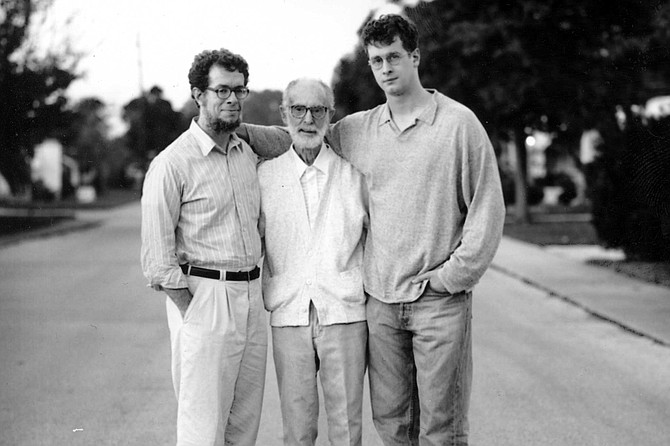
I saved the audiobook of Michael Brendan Daugherty’s memoir My Father Left Me Ireland: An American Son’s Search for Home for the end-of-semester drive to Berkeley to pick up my own son from college. It was excellent company. For Daugherty, the “home” in the title is not merely a place — though it is certainly tied up with place — but a sense of who he is based on where he’s from, in all senses of the term. Daugherty grew up in New Jersey, but his father lived in Ireland, and the distance took a toll. Even so: in a letter to his father, he recounts a surprise visit that Dad paid to his school. “When you had come to the door of my school’s cafeteria and my back was to you, that friend of mine said to me, as if it were nothing, ‘Michael, your dad is here.’ He had never seen you before. He just looked at you and knew. The simple fact that everyone could see about us — even if, at times, I tried to deny it.” We think we are our own, but we are not.
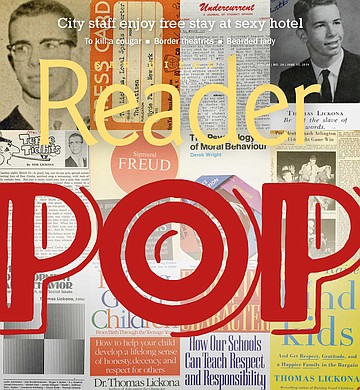
I opened up Pop’s high school yearbook a few days ago: Roosevelt High, Hyde Park, New York, class of 1960. He got his favorite English teacher to sign it: Miss Jean G Walker wrote, “If the pen is really mightier than the sword, what an influence for good you can be!” But under his portrait is the line, “Be not the slave of words.” Turns out it was put there by the yearbook’s editor, the waggish Lucy Vaughn. His classmate Steve Ward took up the joke in his inscription: “Well, Tom, don’t become the slave of words or anything like that.”
Sound counsel, and as he would not be a slave, he sought to become a kind of master. Clarity and concision have been his watchwords ever since Miss Jean G. Walker read one of his essays aloud in class as an example to the other students. He’d unfurled whole reams of hifalutin vocabulary when writing it, and was ready to be heaped with praise for his spectacular verbal display. (She hadn’t named the essay’s author, but he imagined that both teacher and student would rejoice in secret over his achievement.) Instead, Miss Walker looked off into the middle distance and intoned, “Scintillate, scintillate, minute constellation, how I contemplate your existence.” Pop had been put to shame by a nursery rhyme, but he learned his lesson. After he published his first book for a general audience, he said that “the highest compliment I got was from an 11-year-old boy in Wisconsin, who wrote me a letter saying that he had read the whole book and understood all of it.”

Of course, by then, he’d had a couple decades of practice.
Pop is an old newspaperman, and not just because he still reads both his local paper The Cortland Standard and The New York Times in print, though there is that. (And not just reads: when he gets the chance, he reads aloud, at the table, as a starting point for discussion.) It’s more, to use his words, — because he’s a stickler for exact quotes, even in casual conversation, which serves to underscore my point here — that he’s “always written, whether for an academic or general audience, like a journalist, trying to tell interesting, instructive, and inspiring stories.”
These days, those stories involve what he calls “the great, unfolding story of character education,” and he credits “most of what I think I know to watching and listening to people in the trenches — good teachers and good parents, people doing the hard, day-to-day work of trying to help kids grow in goodness.”
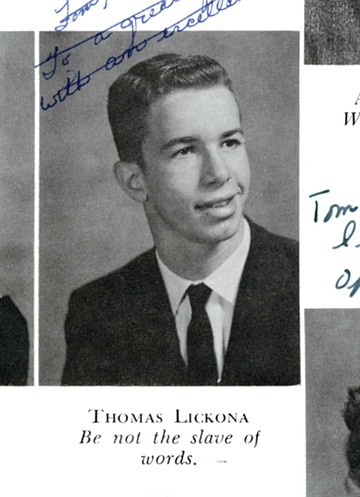
But the stories started with a different sort of goodness, one that was easier to spot and describe: the kind you find in good ballplayers. Pop’s mother liked baseball; she watched to games on a 12” black and white TV while she ironed, and Pop watched with her. Every so often, his father would drive him the 75 miles south to New York City to see the Giants and Dodgers play a night game. “It was the mid-‘50s,” he recalls. “The Giants, Dodgers, and Yankees were all in New York. Mickey Mantle played centerfield for the Yankees, Duke Snyder for the Dodgers, and Mays for the Giants. My friends and I would argue about who was the best, but in my mind there was no doubt that Mays was the greatest baseball player who ever played the game. He was only 5’10” and not big-muscled by today’s standards, but he could throw and hit with amazing power. The first time I saw him throw to home plate from centerfield, it took my breath away. There was no arc to the ball’s flight; it was like it was shot out of a cannon. The first time I saw him hit a home run, the ball rose in a straight line like a rifle shot and caromed off the top of the left field upper deck. And as a centerfielder he could make catches — like the famous one off Vic Wertz in the ‘54 World Series — that were arguably beyond the prowess of other great outfielders.”
He was a fan, but not only a fan. “From the time I was 10, just about every waking minute I wasn’t in school was spent playing or watching sports. I spent hours practicing Mays’ trademark basket catch. We played year round. Baseball in the late spring and summer, touch or tackle football in the fall, and basketball in any season. These were neighborhood pick-up games at Fairview Park at the end of our street. It had a baseball diamond in one corner and a basketball court in the other. There were a lot of kids my age in the neighborhood, so it was always possible to round up enough for a game. Basketball was my favorite. I’d shovel the snow off the court in the winter and practice, practice, practice. Some kids said I was the best shot in the neighborhood, and when I was 14 and in ninth grade, my dream was to make the junior varsity basketball team. But on the first day of tryouts, I was so nervous I couldn’t even make a layup. I didn’t survive the first cut. I remember flopping on my bed when I got home from school and feeling there wasn’t much left to live for.”
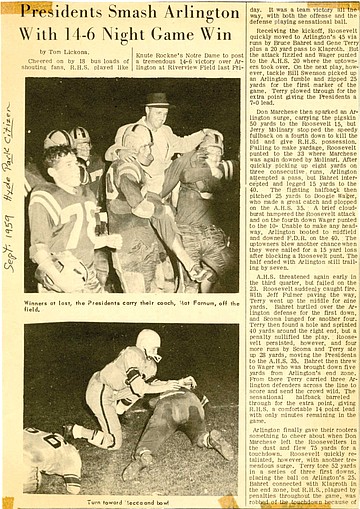
But if he couldn’t make the team, he could cover it. “When I was a sophomore, the town newspaper, The Hyde Park Citizen, was looking for someone to cover Roosevelt High’s sports — soccer, football, basketball, and baseball. I think my English teacher must have recommended me to the paper’s editor, Elizabeth Dowling. She was a very sharp, no-nonsense newspaperwoman who gave me my first typewriter, a manual like the ones you see in the old movies. It was my first job; I got a buck an article. Best of all, I had an official Press Card that got me into any sports event free. It was my proudest possession. I still have it. I had a new dream: to become a sportswriter for a major metropolitan daily. I loved sports, and I loved writing. What could be better than writing about sports for a living?” He kept lists of the ways local sportswriters would describe the same thing in different ways. A basketball player didn’t just make a basket, he “banged a bucket,” “split the twine,” or “kissed the cords.” When he started attending Siena College, he took up reading “the leading New York sportswriters of the day — Dick Young of the Daily News, Red Smith of the Herald Tribune, and Arthur Daley of The New York Times.”
Here and elsewhere, I find myself wondering how my own sons’ sports memories will compare, in terms of both passion and detail. I wonder how mine compare. I wonder if it has to do with reading and writing. But I don’t really wonder; I know what makes a lasting impression. I asked Pop to dig up some of his favorite pieces from high school. He couldn’t find the one about “the most exciting game I ever covered,” but it didn’t matter. Between the watching and the writing, the details came back easily, 60 years later. “Arlington was our arch-rival in basketball. Their star — the best player in the league — was their 5’8” guard Mickey Savino. He was left-handed, and could score from anywhere on the court and make off-balance, hanging-in-the-air hook shots. He was averaging nearly 30 points a game when Arlington came to play on our home court. By the end of the third quarter, it didn’t look good for us. Arlington led by 12. Savino already had 30 points. At the start of the fourth, Roosevelt’s Coach Lewis sent in our number six man, Murray Smith, a senior guard. Unexpectedly, he proceeded to calmly knock down five out of six one-handed set shots from the same spot on the floor, and in a matter of minutes, the score was tied. Our gym was a small bandbox affair and was absolutely packed, and at that point, you couldn’t hear yourself scream.
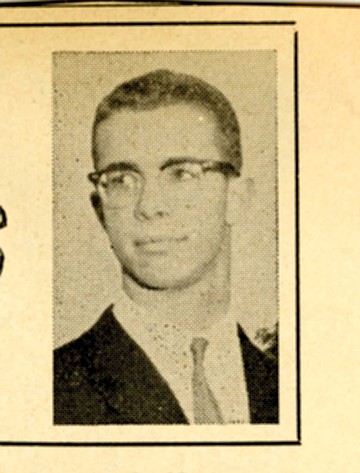
“Roosevelt and Arlington traded baskets for the rest of the fourth quarter, and the game went into overtime. With only two seconds on the clock, the score was tied again at 70-70. Arlington inbounded the ball to Savino, who caught it near the out-of-bounds line, spun, and let fly a one-hander that floated in a high arc nearly the length of the court — and went cleanly through the hoop at the other end as the buzzer sounded. Unbelievable. The Arlington fans went crazy, swarmed onto the floor, and carried him out on their shoulders. He finished with 40 points.”
I’d never heard that story. The one I knew best was more personal: the time Pop took on a future pro, one on one, at his neighborhood court. “Wes Bialosuknia was starting to spend a lot of time at Fairview Park. I was a sophomore and he was an eighth-grader, but he was already over six feet tall, several inches bigger than me. He beat me 50-38, and I figured he could have made it worse if he’d wanted to. But I still have fun bragging about it. As a senior, he led the basketball team to a state championship. At the University of Connecticut, he broke all the basketball scoring records with his mid- and long-range jump-shooting. In his senior year at UConn, he averaged 28 points a game, fifth in the nation — and people say he might have averaged closer to 40 if the three-point rule had been in effect. In 1967, he was drafted by the NBA’s St. Louis Hawks but opted to play for the Oakland Oaks of the new American Basketball Association. That team lasted just two years. In his one year as a pro, he finished second in the league in three-point shooting percentage. After that, he worked as a reporter for a Hartford, Connecticut paper, then opened a sporting goods store and coached youth sports. I was saddened to learn recently that he died at the age of 68 after a long battle with cancer.”
I hadn’t heard that last part before. Life and death happened even to Wondrous Wes — the messy world breaking in and sullying the purer realm of sport.
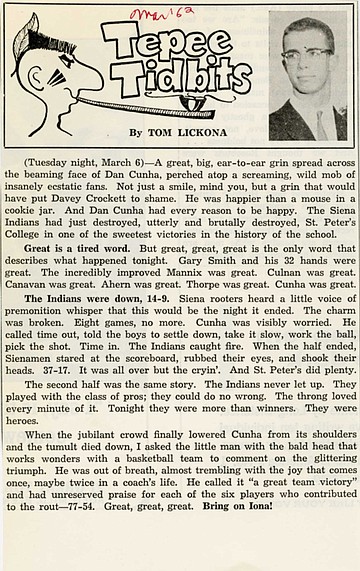
(When I got older, I realized just how silly was that particular notion of purity. But it didn’t feel silly when I was young, and the loves of a happy childhood endure with a ferocity that puts reason to scorn. Or rather, that puts reason in its place. Sure, it’s all about the money, and always has been — Harry Frazee sold Babe Ruth to the Yankees 100 years ago. Sure, there’s precious little connection between athletic prowess and personal goodness — Babe Ruth, who wouldn’t give up women because they were too much fun, will serve again. Sure, the outcome of this or that game means, to quote the father of a close friend, “less than two snails copulating in the garden.” But none of that touches “the thrill of victory and the agony of defeat” touted by ABC’s Wide World of Sports. None of that dims the pleasure of beholding bodies in perfect service to thought and will. None of that negates the fellow-feeling of seeing your team win — or lose. Pop may have left sportswriting behind, but he didn’t leave sports. Tonight at dinner, he grilled my boys on Kawhi Leonard’s playing style and the Raptors’ chances against the Warriors in the NBA finals.
Still, the world broke in on Pop, too. Siena was a Catholic college, and “after three years of covering sports and writing my ‘Teepee Tidbits’ column for the college’s paper, I wanted to write about more than sports. It was 1963, the Second Vatican Council was underway, and change — in the Church and the world — was in the air. We wanted to be part of that, and first of all, we wanted freedom of the press. Under the existing policy, the Dean of Men had to approve everything that went into the student paper. At the start of senior year, a friend and I asked for a Siena News column in which we’d be free to speak candidly about a wide range of campus issues. We were denied. That led us to recruit the best writers on campus to launch a bi-weekly underground newspaper called Undercurrent. We took some criticism for publishing anonymously, but we had two reasons for doing that: we didn’t want to risk expulsion, and we wanted readers to respond to the content of our arguments rather than to who was making them. We published a dozen or so issues over the course of our senior year and stirred campus debate about a lot of things, including beefing up the theology courses so they would have more potential for strengthening students’ faith.” (That’s my Pop: even his rebellion was virtue-minded. What do we want? Beefier theology!)

Changing the world meant changing people, and changing people meant understanding them. His own father was a power plant superintendent for the Hudson River State Hospital, “a large institution from back in the days when they institutionalized most mentally ill people. In high school, I had been friends with three Jewish guys whose parents were all psychiatrists there. They gave me Freud paperbacks — An Introduction to Psychoanalysis and the like — which I wound up reading over summers during college. At the time, Siena didn’t offer a single course in psychology. But after I graduated in 1964, I did a Master’s in English at Ohio University, picked up some psych courses on the side, and then applied to a brand new doctoral program in psychology at the newly expanded State University of New York at Albany. I think they really needed students, so they accepted me with the stipulation that I take a bunch of master’s level courses to make up for what I lacked in psych background. I went on to get my doctorate in psychology with a specialization in child development — in particular, the growth of conscience and character.”
Before he got the doctorate, he got a wife — and a year later, a son: my older brother Mark. “Now that we had a family and my course work was done and my dissertation research underway, we decided it was time for me to get a job. As it happened, the psychology department where I was a doctoral student had just created two instructor-level positions and offered me one. I happily took it and began teaching three classes, one section of Introduction to Psychology and two sections of Child Development.

“My evening child development class consisted of about 25 part-time students, including some teachers, parents, and even a few grandparents. That class was the one I enjoyed the most because they asked questions that required applying psychology to the real world. How should you handle a two-year-old’s temper tantrums? What should you do if your seven-year-old shoplifts? Teaching that class made me know that I wanted a job that would involve applying psychology to real-life problems.
“Initially, I thought that might mean working in a psychological clinic and maybe doing private practice on the side. But then in my final year as a doctoral student, one of my profs, Dr. James Mancuso, invited me to join him once a month in doing consulting as a school psychologist. That was interesting, real-world work. I remember interviewing a 5th-grade boy who was repeatedly stealing from other kids’ lockers and couldn’t tell me any reason why it was wrong to steal except that you might get caught by the principal, the cops, or ‘your old man’ — and get punished.”
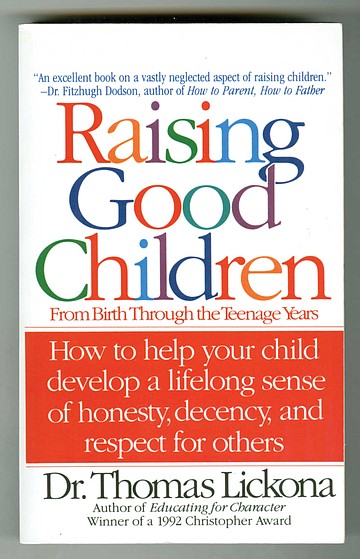
One thing leads to another, and a man with an eye for the main chance can come to some good end. (A lesson I’m trying convey to my own boys.) Dr. Mancuso got an invitation to speak to the faculty of the Campus School at the State University of New York at Cortland. “He asked me if I’d like to come along and present my dissertation research on young children’s moral reasoning. I did, and a year later, they called to ask if I’d be interested in applying for the position of director of a large federal grant in early childhood education that SUNY Cortland had just received from the U.S. Department of Education. I didn’t know anything about early childhood education, and I hadn’t ever directed anything except our underground college newspaper. But I did know about child development. I hit the library to learn everything I could about Head Start and other early childhood educational programs, wrote a 10-page paper on the state of the field and laying out my vision for the grant project — and got the job directing Project Change.”
Just like that, he was designing curricula for both children and grad students, and his career path was set. Well, sort of: education doesn’t occur in a vacuum, perhaps especially when it deals with morality. An illustration: Pop was interested in children’s character. He’d published his parenting book Raising Good Children in 1983, right around the time Bill Bennett, Ronald Reagan’s Secretary of Education established the U.S. Department of Education’s Blue Ribbon Schools program, which recognized schools that provided evidence of excellence not only in academics but also in character and citizenship development.
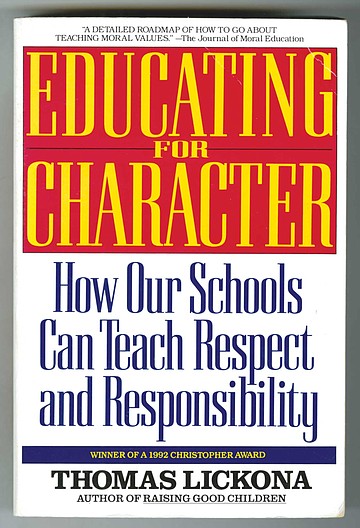
Pop wasn’t an especial fan of Reagan or the GOP, but he appreciated Bennet’s criticism of values clarification: “an approach that told teachers to be value-neutral and just help students ‘clarify’ their own, personally chosen values. This was moral relativism gone to school. If students said — as one class of 8th-graders did — that ‘sex, drugs, and rock and roll’ were their self-chosen values, well, the value-neutral teacher had no ethical criteria for helping them to critically examine those choices. By contrast, character education asserted that that good character consists of objectively good human qualities called virtues. Aristotle explained that virtues such as kindness, justice, self-control, and courage are ‘settled dispositions’ to behave in good ways — ways that are good for the individual and good for the whole society.”
Pop’s 1991 book Educating for Character found him playing journalist again, reporting on ways that schools all over North America “fostered goodness in their students. It described how to use systematically every phase of classroom and school life — the teacher’s example, the peer relationships, the handling of rules and discipline, the resolution of conflicts, the content of the curriculum, the ethos of the school environment, the conduct of sports — all as positive opportunities for fostering character development.”
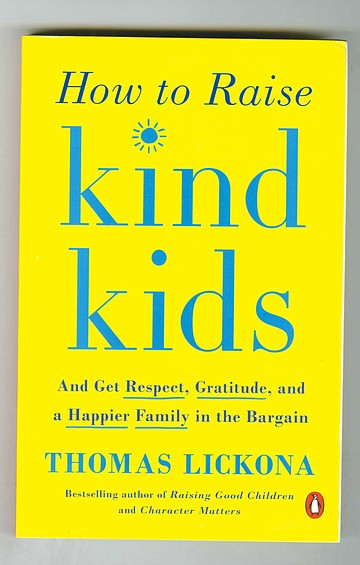
But a college professor has to be careful when agreeing with a Republican Cabinet member. “In 1994, I was fortunate to get two small foundation grants to start what I proposed to call the Center for the 4th and 5th Rs — Respect and Responsibility. Naively, I thought no one could be against a character education center that wants to teach kids respect and responsibility. I was wrong. A handful of influential profs opposed it and called for an investigation by the Faculty Senate because, they said, we had ‘secret funding.’” “Secret” here actually meant “anonymous” — a Catholic foundation with a long-standing policy of permitting no public recognition for its philanthropy. The other grant was from a secular foundation, and the Center’s proposal was public, but Pop’s critics smelled a religious rat.
“I had in fact taken stands on controversial issues as a citizen — in letters to the editor, for example. But in my published writing about character education my position was clear: the public school should treat a controversial issue with fairness and balance, having students learn to critically evaluate conflicting perspectives — or not treat the issue at all. Teaching respect and responsibility — the Center’s work — for the most part meant helping kids to respect their teachers and each other: do their best work, not cheat, be kind, try to stop peer cruelty when they see it, exhibit good sportsmanship at the Friday night football game. In short, be a good, thinking citizen of the small society of the school and the wider community.” (Perhaps the move from good ballplayers to good people was not the seismic shift it seemed at first. Perhaps there was a fundamental consistency between the man who marveled at Mays and the man who strode onto my Little League field calling timeout so he could talk to the umps and coaches about players trying to rattle the batter with chants of “He can’t hit, he can’t hit, he can’t hit.”)
“Nevertheless, I think suspicion about my motives would have forced the Faculty Senate to conduct some sort of inquiry into our funding, except for a surprising development. It happened that my secretary’s brother was an editor for The New York Times Magazine. He decided character education was the latest interesting educational reform effort to try to fix a broken society, and hired the writer Roger Rosenblatt to spend two days with me as a leader of the character education movement. A few weeks later — April 30, 1995 to be exact — my work was the cover story in the magazine: ‘Teaching Johnny to Be Good.’ Off the record, the Provost told me, ‘The Times article took all the steam out of the move to investigate your funding.’” Score one for the old newspaperman.
As for me, the older I get, the more I learn about my father, the more I marvel at the similarities. The devotion to sports and its crucible of character giving way to the devotion to writing and its work of watching and listening. The makeshift collegiate publication. The unexpected professional break that tracks with oddball summer reading (for me, it was New Yorker writer Joseph Mitchell’s anthology Up in the Old Hotel.) And then I marvel that I should marvel at them. We think we are our own, but we are not. Happy Father’s Day, Pop.


I saved the audiobook of Michael Brendan Daugherty’s memoir My Father Left Me Ireland: An American Son’s Search for Home for the end-of-semester drive to Berkeley to pick up my own son from college. It was excellent company. For Daugherty, the “home” in the title is not merely a place — though it is certainly tied up with place — but a sense of who he is based on where he’s from, in all senses of the term. Daugherty grew up in New Jersey, but his father lived in Ireland, and the distance took a toll. Even so: in a letter to his father, he recounts a surprise visit that Dad paid to his school. “When you had come to the door of my school’s cafeteria and my back was to you, that friend of mine said to me, as if it were nothing, ‘Michael, your dad is here.’ He had never seen you before. He just looked at you and knew. The simple fact that everyone could see about us — even if, at times, I tried to deny it.” We think we are our own, but we are not.

I opened up Pop’s high school yearbook a few days ago: Roosevelt High, Hyde Park, New York, class of 1960. He got his favorite English teacher to sign it: Miss Jean G Walker wrote, “If the pen is really mightier than the sword, what an influence for good you can be!” But under his portrait is the line, “Be not the slave of words.” Turns out it was put there by the yearbook’s editor, the waggish Lucy Vaughn. His classmate Steve Ward took up the joke in his inscription: “Well, Tom, don’t become the slave of words or anything like that.”
Sound counsel, and as he would not be a slave, he sought to become a kind of master. Clarity and concision have been his watchwords ever since Miss Jean G. Walker read one of his essays aloud in class as an example to the other students. He’d unfurled whole reams of hifalutin vocabulary when writing it, and was ready to be heaped with praise for his spectacular verbal display. (She hadn’t named the essay’s author, but he imagined that both teacher and student would rejoice in secret over his achievement.) Instead, Miss Walker looked off into the middle distance and intoned, “Scintillate, scintillate, minute constellation, how I contemplate your existence.” Pop had been put to shame by a nursery rhyme, but he learned his lesson. After he published his first book for a general audience, he said that “the highest compliment I got was from an 11-year-old boy in Wisconsin, who wrote me a letter saying that he had read the whole book and understood all of it.”

Of course, by then, he’d had a couple decades of practice.
Pop is an old newspaperman, and not just because he still reads both his local paper The Cortland Standard and The New York Times in print, though there is that. (And not just reads: when he gets the chance, he reads aloud, at the table, as a starting point for discussion.) It’s more, to use his words, — because he’s a stickler for exact quotes, even in casual conversation, which serves to underscore my point here — that he’s “always written, whether for an academic or general audience, like a journalist, trying to tell interesting, instructive, and inspiring stories.”
These days, those stories involve what he calls “the great, unfolding story of character education,” and he credits “most of what I think I know to watching and listening to people in the trenches — good teachers and good parents, people doing the hard, day-to-day work of trying to help kids grow in goodness.”

But the stories started with a different sort of goodness, one that was easier to spot and describe: the kind you find in good ballplayers. Pop’s mother liked baseball; she watched to games on a 12” black and white TV while she ironed, and Pop watched with her. Every so often, his father would drive him the 75 miles south to New York City to see the Giants and Dodgers play a night game. “It was the mid-‘50s,” he recalls. “The Giants, Dodgers, and Yankees were all in New York. Mickey Mantle played centerfield for the Yankees, Duke Snyder for the Dodgers, and Mays for the Giants. My friends and I would argue about who was the best, but in my mind there was no doubt that Mays was the greatest baseball player who ever played the game. He was only 5’10” and not big-muscled by today’s standards, but he could throw and hit with amazing power. The first time I saw him throw to home plate from centerfield, it took my breath away. There was no arc to the ball’s flight; it was like it was shot out of a cannon. The first time I saw him hit a home run, the ball rose in a straight line like a rifle shot and caromed off the top of the left field upper deck. And as a centerfielder he could make catches — like the famous one off Vic Wertz in the ‘54 World Series — that were arguably beyond the prowess of other great outfielders.”
He was a fan, but not only a fan. “From the time I was 10, just about every waking minute I wasn’t in school was spent playing or watching sports. I spent hours practicing Mays’ trademark basket catch. We played year round. Baseball in the late spring and summer, touch or tackle football in the fall, and basketball in any season. These were neighborhood pick-up games at Fairview Park at the end of our street. It had a baseball diamond in one corner and a basketball court in the other. There were a lot of kids my age in the neighborhood, so it was always possible to round up enough for a game. Basketball was my favorite. I’d shovel the snow off the court in the winter and practice, practice, practice. Some kids said I was the best shot in the neighborhood, and when I was 14 and in ninth grade, my dream was to make the junior varsity basketball team. But on the first day of tryouts, I was so nervous I couldn’t even make a layup. I didn’t survive the first cut. I remember flopping on my bed when I got home from school and feeling there wasn’t much left to live for.”

But if he couldn’t make the team, he could cover it. “When I was a sophomore, the town newspaper, The Hyde Park Citizen, was looking for someone to cover Roosevelt High’s sports — soccer, football, basketball, and baseball. I think my English teacher must have recommended me to the paper’s editor, Elizabeth Dowling. She was a very sharp, no-nonsense newspaperwoman who gave me my first typewriter, a manual like the ones you see in the old movies. It was my first job; I got a buck an article. Best of all, I had an official Press Card that got me into any sports event free. It was my proudest possession. I still have it. I had a new dream: to become a sportswriter for a major metropolitan daily. I loved sports, and I loved writing. What could be better than writing about sports for a living?” He kept lists of the ways local sportswriters would describe the same thing in different ways. A basketball player didn’t just make a basket, he “banged a bucket,” “split the twine,” or “kissed the cords.” When he started attending Siena College, he took up reading “the leading New York sportswriters of the day — Dick Young of the Daily News, Red Smith of the Herald Tribune, and Arthur Daley of The New York Times.”
Here and elsewhere, I find myself wondering how my own sons’ sports memories will compare, in terms of both passion and detail. I wonder how mine compare. I wonder if it has to do with reading and writing. But I don’t really wonder; I know what makes a lasting impression. I asked Pop to dig up some of his favorite pieces from high school. He couldn’t find the one about “the most exciting game I ever covered,” but it didn’t matter. Between the watching and the writing, the details came back easily, 60 years later. “Arlington was our arch-rival in basketball. Their star — the best player in the league — was their 5’8” guard Mickey Savino. He was left-handed, and could score from anywhere on the court and make off-balance, hanging-in-the-air hook shots. He was averaging nearly 30 points a game when Arlington came to play on our home court. By the end of the third quarter, it didn’t look good for us. Arlington led by 12. Savino already had 30 points. At the start of the fourth, Roosevelt’s Coach Lewis sent in our number six man, Murray Smith, a senior guard. Unexpectedly, he proceeded to calmly knock down five out of six one-handed set shots from the same spot on the floor, and in a matter of minutes, the score was tied. Our gym was a small bandbox affair and was absolutely packed, and at that point, you couldn’t hear yourself scream.

“Roosevelt and Arlington traded baskets for the rest of the fourth quarter, and the game went into overtime. With only two seconds on the clock, the score was tied again at 70-70. Arlington inbounded the ball to Savino, who caught it near the out-of-bounds line, spun, and let fly a one-hander that floated in a high arc nearly the length of the court — and went cleanly through the hoop at the other end as the buzzer sounded. Unbelievable. The Arlington fans went crazy, swarmed onto the floor, and carried him out on their shoulders. He finished with 40 points.”
I’d never heard that story. The one I knew best was more personal: the time Pop took on a future pro, one on one, at his neighborhood court. “Wes Bialosuknia was starting to spend a lot of time at Fairview Park. I was a sophomore and he was an eighth-grader, but he was already over six feet tall, several inches bigger than me. He beat me 50-38, and I figured he could have made it worse if he’d wanted to. But I still have fun bragging about it. As a senior, he led the basketball team to a state championship. At the University of Connecticut, he broke all the basketball scoring records with his mid- and long-range jump-shooting. In his senior year at UConn, he averaged 28 points a game, fifth in the nation — and people say he might have averaged closer to 40 if the three-point rule had been in effect. In 1967, he was drafted by the NBA’s St. Louis Hawks but opted to play for the Oakland Oaks of the new American Basketball Association. That team lasted just two years. In his one year as a pro, he finished second in the league in three-point shooting percentage. After that, he worked as a reporter for a Hartford, Connecticut paper, then opened a sporting goods store and coached youth sports. I was saddened to learn recently that he died at the age of 68 after a long battle with cancer.”
I hadn’t heard that last part before. Life and death happened even to Wondrous Wes — the messy world breaking in and sullying the purer realm of sport.

(When I got older, I realized just how silly was that particular notion of purity. But it didn’t feel silly when I was young, and the loves of a happy childhood endure with a ferocity that puts reason to scorn. Or rather, that puts reason in its place. Sure, it’s all about the money, and always has been — Harry Frazee sold Babe Ruth to the Yankees 100 years ago. Sure, there’s precious little connection between athletic prowess and personal goodness — Babe Ruth, who wouldn’t give up women because they were too much fun, will serve again. Sure, the outcome of this or that game means, to quote the father of a close friend, “less than two snails copulating in the garden.” But none of that touches “the thrill of victory and the agony of defeat” touted by ABC’s Wide World of Sports. None of that dims the pleasure of beholding bodies in perfect service to thought and will. None of that negates the fellow-feeling of seeing your team win — or lose. Pop may have left sportswriting behind, but he didn’t leave sports. Tonight at dinner, he grilled my boys on Kawhi Leonard’s playing style and the Raptors’ chances against the Warriors in the NBA finals.
Still, the world broke in on Pop, too. Siena was a Catholic college, and “after three years of covering sports and writing my ‘Teepee Tidbits’ column for the college’s paper, I wanted to write about more than sports. It was 1963, the Second Vatican Council was underway, and change — in the Church and the world — was in the air. We wanted to be part of that, and first of all, we wanted freedom of the press. Under the existing policy, the Dean of Men had to approve everything that went into the student paper. At the start of senior year, a friend and I asked for a Siena News column in which we’d be free to speak candidly about a wide range of campus issues. We were denied. That led us to recruit the best writers on campus to launch a bi-weekly underground newspaper called Undercurrent. We took some criticism for publishing anonymously, but we had two reasons for doing that: we didn’t want to risk expulsion, and we wanted readers to respond to the content of our arguments rather than to who was making them. We published a dozen or so issues over the course of our senior year and stirred campus debate about a lot of things, including beefing up the theology courses so they would have more potential for strengthening students’ faith.” (That’s my Pop: even his rebellion was virtue-minded. What do we want? Beefier theology!)

Changing the world meant changing people, and changing people meant understanding them. His own father was a power plant superintendent for the Hudson River State Hospital, “a large institution from back in the days when they institutionalized most mentally ill people. In high school, I had been friends with three Jewish guys whose parents were all psychiatrists there. They gave me Freud paperbacks — An Introduction to Psychoanalysis and the like — which I wound up reading over summers during college. At the time, Siena didn’t offer a single course in psychology. But after I graduated in 1964, I did a Master’s in English at Ohio University, picked up some psych courses on the side, and then applied to a brand new doctoral program in psychology at the newly expanded State University of New York at Albany. I think they really needed students, so they accepted me with the stipulation that I take a bunch of master’s level courses to make up for what I lacked in psych background. I went on to get my doctorate in psychology with a specialization in child development — in particular, the growth of conscience and character.”
Before he got the doctorate, he got a wife — and a year later, a son: my older brother Mark. “Now that we had a family and my course work was done and my dissertation research underway, we decided it was time for me to get a job. As it happened, the psychology department where I was a doctoral student had just created two instructor-level positions and offered me one. I happily took it and began teaching three classes, one section of Introduction to Psychology and two sections of Child Development.

“My evening child development class consisted of about 25 part-time students, including some teachers, parents, and even a few grandparents. That class was the one I enjoyed the most because they asked questions that required applying psychology to the real world. How should you handle a two-year-old’s temper tantrums? What should you do if your seven-year-old shoplifts? Teaching that class made me know that I wanted a job that would involve applying psychology to real-life problems.
“Initially, I thought that might mean working in a psychological clinic and maybe doing private practice on the side. But then in my final year as a doctoral student, one of my profs, Dr. James Mancuso, invited me to join him once a month in doing consulting as a school psychologist. That was interesting, real-world work. I remember interviewing a 5th-grade boy who was repeatedly stealing from other kids’ lockers and couldn’t tell me any reason why it was wrong to steal except that you might get caught by the principal, the cops, or ‘your old man’ — and get punished.”

One thing leads to another, and a man with an eye for the main chance can come to some good end. (A lesson I’m trying convey to my own boys.) Dr. Mancuso got an invitation to speak to the faculty of the Campus School at the State University of New York at Cortland. “He asked me if I’d like to come along and present my dissertation research on young children’s moral reasoning. I did, and a year later, they called to ask if I’d be interested in applying for the position of director of a large federal grant in early childhood education that SUNY Cortland had just received from the U.S. Department of Education. I didn’t know anything about early childhood education, and I hadn’t ever directed anything except our underground college newspaper. But I did know about child development. I hit the library to learn everything I could about Head Start and other early childhood educational programs, wrote a 10-page paper on the state of the field and laying out my vision for the grant project — and got the job directing Project Change.”
Just like that, he was designing curricula for both children and grad students, and his career path was set. Well, sort of: education doesn’t occur in a vacuum, perhaps especially when it deals with morality. An illustration: Pop was interested in children’s character. He’d published his parenting book Raising Good Children in 1983, right around the time Bill Bennett, Ronald Reagan’s Secretary of Education established the U.S. Department of Education’s Blue Ribbon Schools program, which recognized schools that provided evidence of excellence not only in academics but also in character and citizenship development.

Pop wasn’t an especial fan of Reagan or the GOP, but he appreciated Bennet’s criticism of values clarification: “an approach that told teachers to be value-neutral and just help students ‘clarify’ their own, personally chosen values. This was moral relativism gone to school. If students said — as one class of 8th-graders did — that ‘sex, drugs, and rock and roll’ were their self-chosen values, well, the value-neutral teacher had no ethical criteria for helping them to critically examine those choices. By contrast, character education asserted that that good character consists of objectively good human qualities called virtues. Aristotle explained that virtues such as kindness, justice, self-control, and courage are ‘settled dispositions’ to behave in good ways — ways that are good for the individual and good for the whole society.”
Pop’s 1991 book Educating for Character found him playing journalist again, reporting on ways that schools all over North America “fostered goodness in their students. It described how to use systematically every phase of classroom and school life — the teacher’s example, the peer relationships, the handling of rules and discipline, the resolution of conflicts, the content of the curriculum, the ethos of the school environment, the conduct of sports — all as positive opportunities for fostering character development.”

But a college professor has to be careful when agreeing with a Republican Cabinet member. “In 1994, I was fortunate to get two small foundation grants to start what I proposed to call the Center for the 4th and 5th Rs — Respect and Responsibility. Naively, I thought no one could be against a character education center that wants to teach kids respect and responsibility. I was wrong. A handful of influential profs opposed it and called for an investigation by the Faculty Senate because, they said, we had ‘secret funding.’” “Secret” here actually meant “anonymous” — a Catholic foundation with a long-standing policy of permitting no public recognition for its philanthropy. The other grant was from a secular foundation, and the Center’s proposal was public, but Pop’s critics smelled a religious rat.
“I had in fact taken stands on controversial issues as a citizen — in letters to the editor, for example. But in my published writing about character education my position was clear: the public school should treat a controversial issue with fairness and balance, having students learn to critically evaluate conflicting perspectives — or not treat the issue at all. Teaching respect and responsibility — the Center’s work — for the most part meant helping kids to respect their teachers and each other: do their best work, not cheat, be kind, try to stop peer cruelty when they see it, exhibit good sportsmanship at the Friday night football game. In short, be a good, thinking citizen of the small society of the school and the wider community.” (Perhaps the move from good ballplayers to good people was not the seismic shift it seemed at first. Perhaps there was a fundamental consistency between the man who marveled at Mays and the man who strode onto my Little League field calling timeout so he could talk to the umps and coaches about players trying to rattle the batter with chants of “He can’t hit, he can’t hit, he can’t hit.”)
“Nevertheless, I think suspicion about my motives would have forced the Faculty Senate to conduct some sort of inquiry into our funding, except for a surprising development. It happened that my secretary’s brother was an editor for The New York Times Magazine. He decided character education was the latest interesting educational reform effort to try to fix a broken society, and hired the writer Roger Rosenblatt to spend two days with me as a leader of the character education movement. A few weeks later — April 30, 1995 to be exact — my work was the cover story in the magazine: ‘Teaching Johnny to Be Good.’ Off the record, the Provost told me, ‘The Times article took all the steam out of the move to investigate your funding.’” Score one for the old newspaperman.
As for me, the older I get, the more I learn about my father, the more I marvel at the similarities. The devotion to sports and its crucible of character giving way to the devotion to writing and its work of watching and listening. The makeshift collegiate publication. The unexpected professional break that tracks with oddball summer reading (for me, it was New Yorker writer Joseph Mitchell’s anthology Up in the Old Hotel.) And then I marvel that I should marvel at them. We think we are our own, but we are not. Happy Father’s Day, Pop.